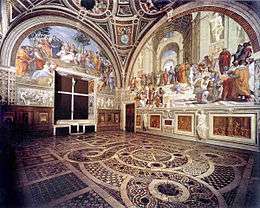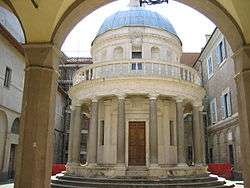High Renaissance


In art history, High Renaissance, is the period denoting the apogee of the visual arts in the Italian Renaissance. The High Renaissance period is traditionally taken to begin in the 1490s, with Leonardo's fresco of the Last Supper in Milan and the death of Lorenzo de' Medici in Florence, and to have ended in 1527 with the sacking of Rome by the troops of Charles V. This term was first used in German (Hochrenaissance) in the early nineteenth century, and has its origins in the "High Style" of painting and sculpture described by Johann Joachim Winckelmann.[1] Over the last twenty years, use of the term has been frequently criticized by academic art historians for oversimplifying artistic developments, ignoring historical context, and focusing only on a few iconic works.[2]
Overview
Since the late eighteenth century, the High Renaissance has been taken to refer to a short (c. 30-year) period of exceptional artistic production in the Italian states, principally Rome, capital of the Papal States, under Pope Julius II. Assertions about where and when the period begins and ends vary, but in general the best-known exponents of painting of the High Renaissance, include Leonardo da Vinci, early Michelangelo and Raphael. Extending the general rubric of Renaissance culture, the visual arts of the High Renaissance were marked by a renewed emphasis upon the classical tradition, the expansion of networks of patronage, and a gradual attenuation of figural forms into the style later termed Mannerism.
The paintings in the Vatican by Michelangelo and Raphael are said by some scholars such as Stephen Freedberg to represent the culmination of High Renaissance style in painting, because of the ambitious scale of these works, coupled with the complexity of their composition, closely observed human figures, and pointed iconographic and decorative references to classical antiquity, can be viewed as emblematic of the High Renaissance.[3] In more recent years, art historians have characterised the High Renaissance as a movement as opposed to a period, one amongst several different experimental attitudes towards art in the late fifteenth and early sixteenth century. This movement is variously characterised as conservative;[4] as reflecting new attitudes towards beauty;[5] a deliberate process of synthesising eclectic models, linked to fashions in literary culture;[6] and reflecting new preoccupations with interpretation and meaning .[7]
Architecture

High Renaissance style in architecture conventionally begins with Donato Bramante, whose Tempietto at S. Pietro in Montorio at Rome was begun in 1510. The Tempietto, signifies a full-scale revival of ancient Roman commemorative architecture. David Watkin writes that the Tempietto, like Raphael's works in the Vatican (1509–11), "is an attempt at reconciling Christian and humanist ideals".[8]
Painting
The High Renaissance was traditionally viewed as a great explosion of creative genius, following a model of art history first proposed by the Florentine Giorgio Vasari. Even relatively minor painters of the period, such as Fra Bartolomeo and Mariotto Albertinelli, produced works that are still lauded for the harmony of their design and their technique. The elongated proportions and exaggerated poses in the late works of Michelangelo, Andrea del Sarto and Correggio prefigure so-called Mannerism, as the style of the later Renaissance is referred to in art history.
The serene mood and luminous colours of paintings by Giorgione and early Titian exemplify High Renaissance style as practiced in Venice. Other recognizable pieces of this period include Leonardo da Vinci's Mona Lisa and Raphael's The School of Athens. Raphael's fresco, set beneath an arch, is a virtuoso work of perspective, composition and disegno.
Sculpture

High Renaissance sculpture, as exemplified by Michelangelo's Pietà and the iconic David, is characterized by an "ideal" balance between stillness and movement. High Renaissance sculpture was normally commissioned by the public and the state, this becoming more popular for sculpture is an expensive art form. Sculpture was often used to decorate or embellish architecture, normally within courtyards where others were able to study and admire the commissioned art work. Wealthy individuals like cardinals, rulers and bankers were the more likely private patrons along with very wealthy families; Pope Julius II also patronized many artists. During the High Renaissance there was the development of small scale statuettes for private patrons, the creation of busts and tombs also developing. The subject matter related to sculpture was mostly religious but also with a significant strand of classical individuals in the form of tomb sculpture and paintings as well as ceilings of cathedrals.
References
- ↑ Jill Burke, "Inventing the High Renaissance from Winckelmann to Wikipedia: an introductory essay", in: Id., Rethinking the High Renaissance: Culture and the Visual Arts in Early Sixteenth-century Rome, Ashgate, 2012
- ↑ Marcia Hall, “Classicism, Mannerism and the Relieflike Style” in The Cambridge Companion to Raphael, Cambridge: Cambridge University Press, p. 224.
- ↑ Stephen Freedberg, _Painting of the High Renaissance in Rome and Florence, 2 vols., Cambridge MA; Harvard University Press
- ↑ Alexander Nagel, "Experiments in Art and Reform in Italy in the Early Sixteenth dick Century", in Kenneth Gouwens and Sheryl E. Reiss eds., The Pontificate of Clement VII: History, Politics, Culture, Ashgate 2005, 385–409
- ↑ Elizabeth Cropper, "The Place of Beauty in the High Renaissance and its Displacement in the History of Art", in Alvin Vos ed., Place and Displacement in the Renaissance, 1995, 159–205
- ↑ David Hemsoll, 'The conception and design of Michelangelo's Sistine Chapel ceiling: 'wishing to shed a little light upon the whole rather than mentioning the parts', in Jill Burke ed., Rethinking the High Renaissance, Ashgate, 2012
- ↑ Jill Burke, 'Meaning and Crisis in the Early Sixteenth Century: Interpreting Leonardo's Lion', Oxford Art Journal, 29, 2006, 77–91
- ↑ D. Watkin, A History of Western Architecture, 4th ed., Watson Guptill (2005) p. 224.
External links
| Wikimedia Commons has media related to Italian Renaissance art. |
| ||||||||||||||||||||||

